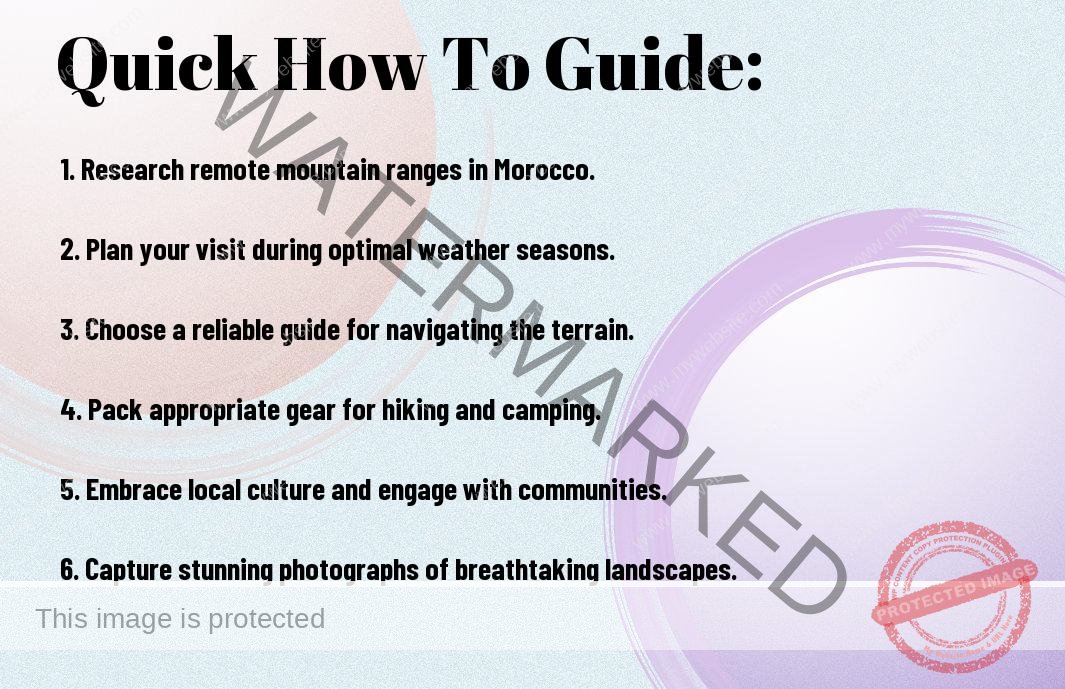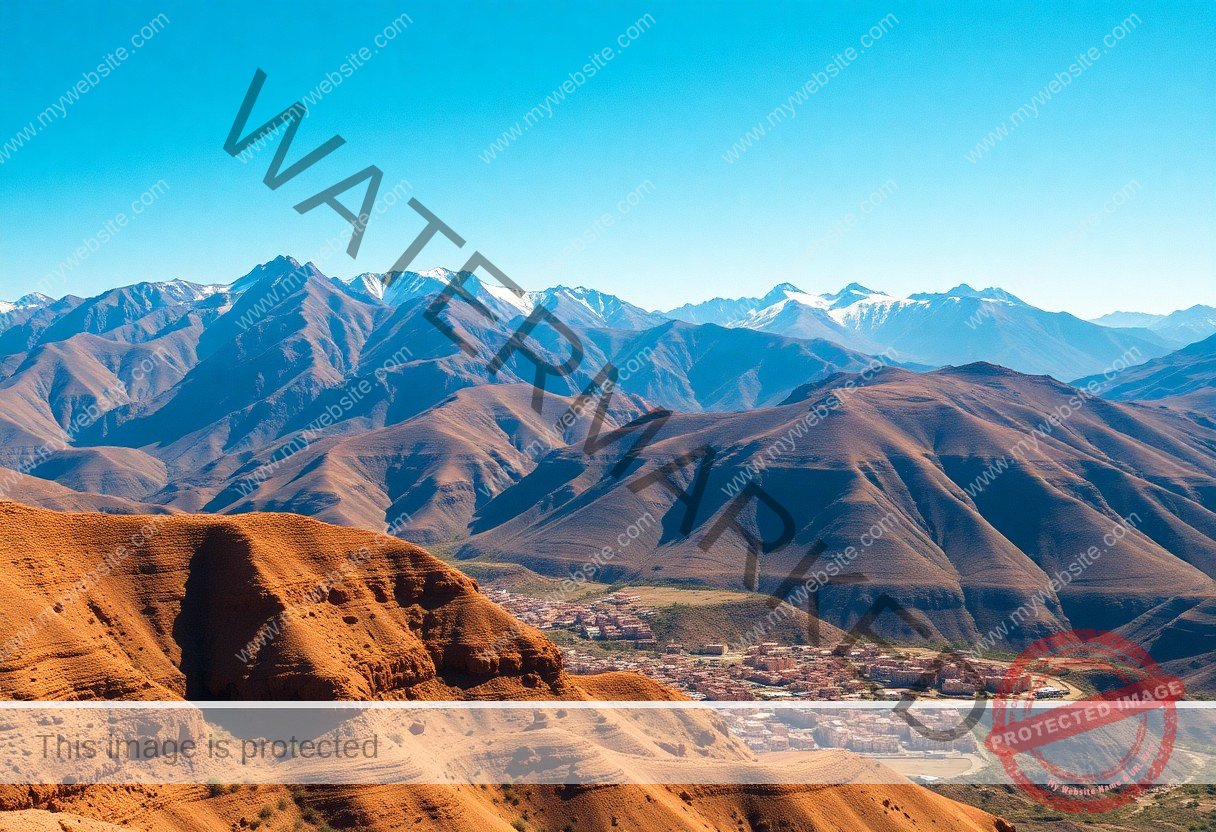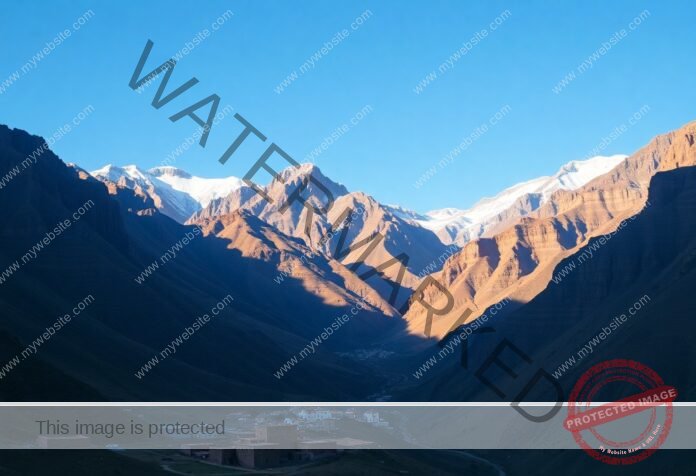Many travelers seek the breathtaking scenery that Morocco’s remote peaks offer, from the soaring Atlas Mountains to the serene ridges of the Rif. Engaging with this stunning landscape provides you with an opportunity to immerse yourself in the rich culture, vibrant traditions, and idyllic vistas that define this enchanting region. In this guide, you’ll discover the best ways to explore these hidden gems, ensuring you capture the ethereal beauty of Morocco and create unforgettable memories along the way.
Advertisement
Key Takeaways:
- Explore the secluded regions: Venture into the less-traveled areas like the High Atlas or Anti-Atlas mountains for stunning vistas and a true sense of tranquility.
- Engage with local culture: Take time to connect with Berber communities to gain insight into their traditions and customs, enhancing your experience in these remote areas.
- Plan your activities: Consider activities such as trekking, horseback riding, or mountain biking to fully immerse yourself in the natural beauty and rugged landscape.
- Adjust to the climate: Be prepared for temperature fluctuations and pack appropriately to ensure comfort during your exploration of the peaks.
- Capture the moments: Bring a camera to document the breathtaking scenery, memorable interactions, and the unique charm of Morocco’s remote mountainous regions.

How to Choose the Right Time to Visit
The beauty of Morocco’s remote peaks can be experienced differently depending on when you choose to visit. Understanding the seasonal dynamics can significantly enhance your trip. The best periods for trekking and sightseeing often come during the spring and fall months. During these times, the weather tends to be mild and the landscapes vibrant, providing you with picturesque views and comfortable conditions for exploration.
Seasonal Considerations
An important aspect to consider is the specific season you plan to visit. Spring, from March to May, showcases blooming wildflowers and is perfect for outdoor activities. Similarly, fall, from September to November, brings cooler temperatures and fewer tourists, allowing for a more serene experience. In contrast, summer can be quite scorching in the valleys while still offering pleasant conditions at higher altitudes. Winter, specifically from December to February, brings snow to the peaks, creating stunning contrasts for photography enthusiasts but requiring proper gear for trekking.
Weather Factors
An understanding of the weather patterns will greatly enhance your experience in the Moroccan mountain ranges. You can expect various temperatures depending on your altitude and location, making it vital to prepare for both warmth and chill. Higher peaks can experience drastic temperature drops, especially in the early morning and late evening hours. For your outdoor activities, consider the following:
- Daytime temperatures can vary widely; dress in layers.
- Evenings can turn quite cold, particularly in winter and early spring.
- Be prepared for sudden changes in weather as mountain conditions can shift quickly.
- Plan your excursions to avoid the highest heat levels during summer months.
- Assume that clouds can roll in unexpectedly, impacting visibility.
An assessment of your planned activities can help you decide the best weather conditions for your visit. For trekking and climbing, late spring or early fall typically offers the most favorable conditions. Conversely, if you’re looking to experience the beauty of snow-capped mountains, winter is indeed the season for you. Make sure to consider these factors in your travel plans:
- Altitude affects climate: higher areas are cooler and can be snowy.
- Rain is more common in winter; prepare accordingly.
- Clear days typically occur in spring and fall, ideal for photography.
- Traveling during local holidays can enhance your cultural experience.
- Assume that each season offers a unique perspective of the mountains.
Tips for Accessing Remote Peaks
While planning your adventure to the remote peaks of Morocco, it’s vital to consider the accessibility of these magnificent sites. These peaks, while breathtaking, can be challenging to reach due to the rugged terrain. To make your trip smoother, keep the following tips in mind:
- Research your chosen peak ahead of time to understand the best routes.
- Check seasonal weather conditions to avoid unexpected challenges.
- Consider hiring a local guide who knows the area well.
- Invest in a good map or GPS device for navigation in less mapped areas.
- Pack adequate supplies, including water and snacks, for your journey.
Any travel experience to Morocco’s remote peaks is best enriched by preparations that respect the local landscape and culture. For a sense of distance, An hour’s drive and a thousand miles away from Marrakech will transport you to a world vastly different from the urban environment you may be accustomed to.
Choosing the Best Routes
Remote peaks can be far apart and only accessible by specific routes, so choosing the right path is vital for your adventure. You can opt for well-trodden trails that are frequently used by locals and hikers, providing safety and a reliable way to enjoy the scenery. Or, if you’re feeling adventurous, consider venturing off the beaten path, but proceed with caution, ensuring that you have enough skills and knowledge for navigation.
No matter which route you choose, be sure to take your time to fully absorb the natural beauty that surrounds you. Connect with the locals who often serve as the best sources of information on routes that others might not know. This will give you a taste of authentic Moroccan culture and offer insights into the hidden gems located in these remote areas.
Transportation Options
An equally important aspect of your journey is how you will reach these remote peaks. The terrain can be challenging, and public transportation may not always run frequently. Depending on your preferences, you could consider renting a vehicle for flexibility or using a guided tour that includes transportation. Many visitors opt for 4×4 cars, especially if they plan to explore off-road areas.
Options are plentiful when it comes to planning your transportation in Morocco. If you prefer public transit, buses travel between cities, but may not reach the very heart of the mountains you wish to explore. Alternatively, shared taxis may offer a quicker, albeit less comfortable, way to travel. Hiring a local guide with a vehicle tailored for the rugged terrain can enhance your experience, ensuring you reach even the most remote peaks safely and with ease. Whichever option you choose, being prepared will set the tone for an unforgettable adventure in Morocco’s stunning landscapes.

Essential Gear for Mountain Exploration
Despite the allure of Morocco’s breathtaking mountains, your adventure can quickly turn into a daunting experience without the right gear. Adequate preparation is key to enjoying the stunning landscapes while ensuring your safety and comfort. For those seeking more information on nomadic travel & intrepid adventures through Morocco’s remote peaks, check out this resource to get the inside scoop on what to expect. From high-altitude treks to unpredictable weather, being equipped with the right tools will enhance your journey into the wilderness.
Clothing and Footwear
Essential clothing and footwear will make a significant impact on your mountain exploration. Layering is the best approach; start with moisture-wicking base layers, add an insulating mid-layer, and finish with a breathable and waterproof outer shell. Aim for durable, quick-drying pants that allow for easy movement, along with thermal gloves and a warm hat to guard against the chill at higher elevations. Your footwear should not only be sturdy but also provide ample support for your ankles—consider investing in quality hiking boots designed for rugged terrains.
Safety Equipment
Safety equipment is another key component of your mountain gear. Carrying a reliable first-aid kit, headlamp, and multi-tool can be lifesavers in emergencies. It’s also wise to take a map and compass, and familiarize yourself with navigation techniques, as mobile service can be unreliable in remote areas. Depending on the season and trail conditions, additional gear such as a whistle or bear spray may also be prudent.
This combination of clothing, footwear, and safety equipment will prepare you for various situations, ensuring that your exploration of Morocco’s remote peaks is not only enjoyable but also safe. Whether you encounter a sudden change in weather or need to navigate unfamiliar paths, being equipped with the right tools will leave you feeling confident as you traverse these enchanting landscapes.
How to Immerse Yourself in Local Culture
Now that you’ve made your way to the enchanting landscape of Morocco’s remote peaks, it’s time to research into the rich tapestry of local culture. Engaging with the indigenous communities will not only enhance your travel experience but also provide you with a deeper understanding of their customs and way of life. From the Berbers’ traditional hospitality to their vibrant storytelling, every interaction offers a glimpse into a culture that has thrived in harmony with the stunning mountain surroundings for centuries.
Engaging with Indigenous Communities
With the right approach, you can connect deeply with the indigenous people. Seek out opportunities to visit local villages where you can participate in community gatherings and learn about their daily routines. These interactions often involve sharing a meal, where you can savor traditional dishes such as tagine or couscous while hearing captivating stories from the locals. You’ll find that these welcoming communities are eager to share their history and insights, which will provide you with a richer context for your adventure in the peaks.
Participating in Traditional Activities
With various traditional activities available, there’s no shortage of ways to immerse yourself in local culture. Consider joining a pottery workshop or a weaving session to understand the craftsmanship behind their renowned artisan products. You might even find yourself participating in local festivals, which often feature music, dance, and traditional attire, offering an unforgettable experience that engages all of your senses. Not only will these activities help support the local economy, but they will also create lasting memories of your time in Morocco.
Communities in the mountains are often eager to showcase their heritage through hands-on experiences. By participating in traditional hunting or herding activities, you will gain insight into the symbiotic relationship between the locals and their environment. Often guided by experienced locals, you may find yourself trekking with livestock or learning to use traditional tools, allowing you to connect on a more profound level with the landscape and the traditions that have persisted through generations.
Photography Tips to Capture the Ethereal Beauty
Unlike bustling cityscapes, the remote peaks of Morocco present a canvas of unparalleled beauty that you will want to document. To capture these stunning natural vistas, it’s necessary to equip yourself with the right techniques. Consider using a tripod to stabilize your camera, especially during low-light conditions, and experiment with long exposure settings to create smooth, ethereal effects in your landscape shots. Here are some tips to enhance your photography experience:
- Explore various times of the day for the best lighting.
- Incorporate local elements into your compositions for depth.
- Carry a polarizing filter to manage glare from the sun.
- Don’t hesitate to capture your journey; candid moments often tell the best stories.
Assume that each photograph you take is an opportunity to unveil the mystique of the Moroccan landscape. For inspiration, check out the Premiere: this dreamlike Super 8 short film explores … which beautifully showcases the enchanting allure of these remote areas.
Best Times for Natural Lighting
To capture the best light, timing can significantly impact the visual quality of your photographs. The magical “golden hour,” which occurs shortly after sunrise and before sunset, will bathe the Moroccan peaks in warm, soft light, enhancing textures and colors. Midday sun can be harsh, so it’s often advisable to take a break during this period, allowing you to plan for shooting when the shadows lengthen and the light softens.
Suggested Angles and Perspectives
Natural landscapes can be dramatically enhanced by varying your angles and perspectives. Try crouching low to incorporate foreground elements or climbing to a higher vantage point to capture sweeping vistas. Utilize leading lines within the landscape to guide the viewer’s eye towards the peaks, creating a sense of depth and drawing focus to your subject.
Plus, consider including some of the unique rock formations or vibrant flora in your shots to add interest to your compositions. Emphasizing the scale of the peaks by juxtaposing them with small figures or local architecture can create stunning contrasts in your images. Whether you’re aiming for close-ups or grand landscapes, varying your perspectives allows you to capture the true essence of Morocco’s ethereal beauty.
Understanding the Environmental Factors
Not all mountain experiences are the same, and the environmental factors that influence your adventure in Morocco’s remote peaks are vital to understand. The climate, altitude, and local flora and fauna play significant roles in shaping your journey and overall experience. As you prepare for this trip, consider the following elements:
- Climate: Be aware of the seasonal changes and the range of temperatures you’ll encounter.
- Altitude: Understand how high elevation can affect your physical well-being and acclimatization needs.
- Wildlife: Familiarize yourself with the native species you’ll likely encounter and how to interact with the environment responsibly.
- Safety: Prepare for unexpected weather patterns and potential challenges that could arise from the elevation.
Knowing these factors will enable you to fully appreciate and navigate the stunning landscapes of Morocco while ensuring a safe and enjoyable experience.
Preserving the Natural Landscape
An appreciation for Morocco’s majestic peaks goes hand in hand with the responsibility of preserving their natural beauty. You must recognize that each step you take impacts the fragile ecosystems that thrive in these remote areas. By practicing Leave No Trace principles and being mindful of your surroundings, you contribute to the sustainability of these breathtaking landscapes for future generations. Carry out what you bring in, avoid disturbing wildlife, and opt for eco-friendly products to minimize your impact.
Furthermore, consider support for local conservation efforts, as many organizations are working tirelessly to protect the delicate balance of these mountainous regions. By engaging with the local community, you can learn about the importance of preserving their environment and, in turn, help safeguard the beauty you came to enjoy. Your choices can make a significant difference in the health of Morocco’s remote peaks.
Impact of Altitude on Experience
Impact your adventure as you navigate the varying altitudes of Morocco’s mountainous regions, as altitude can significantly affect how you feel. As you ascend, you may notice that physical exertion becomes more challenging due to decreased oxygen levels. It’s vital to stay hydrated and to allow your body time to acclimatize. Listening to your body is vital; take breaks when needed and avoid pushing too hard in the initial stages of your ascent.
It is not uncommon to experience symptoms such as headaches, fatigue, or shortness of breath at higher elevations. Being prepared with appropriate gear and sufficient oxygen intake can help you manage these effects. Ultimately, embracing the journey through varying altitudes will allow you to witness some of the most stunning views. Adjusting your physical expectations and planning activities accordingly will ensure that your experience in Morocco’s remote peaks is not only beautiful but also rewarding.
Summing up
Ultimately, to truly experience the ethereal beauty of Morocco’s remote peaks, you must venture beyond the tourist trails and immerse yourself in the stunning landscapes that await you. Embarking on a trekking adventure through the High Atlas or Toubkal National Park allows you to connect with the dramatic mountains, charming Berber villages, and vibrant flora and fauna. You can also engage with local cultures, learning about their traditions and ways of life, which adds depth to your experience. Whether you choose a guided tour or prefer to explore independently, you will find that every turn reveals a breathtaking vista or a hidden gem.
Your journey should also incorporate various modes of transport, from hiking and horseback riding to the exhilarating drive along winding mountain roads. This diverse exploration not only heightens your appreciation of the natural beauty but also ensures that you capture the essence of Morocco’s peaks from different perspectives. By planning your itinerary with a blend of adventure, cultural encounters, and relaxation, you will create unforgettable memories while soaking in the ethereal splendor of this remarkable region.
FAQ
Q: What are the best times to visit the remote peaks of Morocco for an ethereal experience?
A: The ideal times to explore Morocco’s remote peaks are during spring (March to May) and autumn (September to November). During these seasons, temperatures are more moderate, and you can enjoy vibrant wildflowers in spring and stunning autumn colors. Additionally, the weather conditions are generally stable, allowing for clear skies and breathtaking views of the landscapes.
Q: How can I reach the remote peaks of Morocco, and what kind of transportation is recommended?
A: To access the remote peaks, it’s advisable to hire a local guide who is familiar with the area. Many travelers choose to rent a 4×4 vehicle or join a guided tour that includes transportation to the mountains. Public transport can be limited, so having a reliable means of transport is crucial, especially for reaching less accessible regions.
Q: What activities can visitors engage in to truly appreciate the beauty of the peaks?
A: Visitors can partake in various activities such as hiking, trekking, and mountain climbing, which provide an intimate experience of the natural beauty. Photographers can capture the surreal landscapes at sunrise or sunset, while those seeking cultural immersion can visit local Berber villages nestled in the mountains. Additionally, options for guided nature walks and bird watching are abundant in these areas.
Q: Are there any specific locations or peaks that are considered must-visit for their beauty?
A: Yes, several peaks are renowned for their stunning vistas, including Toubkal, the highest mountain in North Africa, and the Ait Bouguemmez valley, often referred to as the “Happy Valley.” The Anti-Atlas mountains also offer spectacular views and unique rock formations. Each of these locations provides a unique blend of natural beauty and cultural experiences.
Q: What should I pack for visiting the remote peaks of Morocco?
A: Packing crucials include sturdy hiking boots, layered clothing suitable for varying temperatures, a high-quality camera for capturing the scenic views, and sufficient water and snacks for your excursions. Don’t forget sun protection, such as sunglasses and sunscreen, as well as a headlamp or flashlight if you plan on trekking in low-light conditions.

